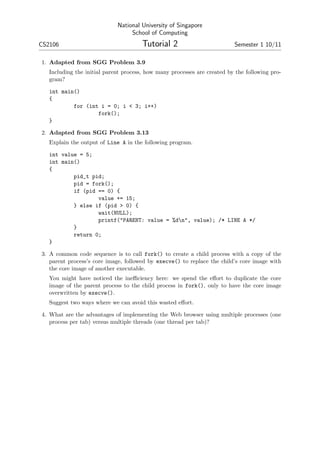CS2106 Tutorial 2
•
0 j'aime•554 vues
1) 7 processes will be created as each fork() call duplicates the current process. With 3 iterations of fork(), 2^3 = 8 processes are created. 2) The output of Line A will be "PARENT: value = 5" as the child process increments its copy of value to 20 but the parent's value is unchanged. 3) Two ways to avoid duplicating the core image during fork() only to overwrite it during execve() are: 1) Call execve() directly in the parent without forking. 2) Use vfork() instead of fork() which does not duplicate the memory space until execve() is called.
Signaler
Partager
Signaler
Partager
Télécharger pour lire hors ligne

Recommandé
Internet Routing Protocols: Fundamental Concepts of Distance-Vector and Link-...

Internet Routing Protocols: Fundamental Concepts of Distance-Vector and Link-...Vishal Sharma, Ph.D.
Contenu connexe
Tendances (8)
En vedette
Internet Routing Protocols: Fundamental Concepts of Distance-Vector and Link-...

Internet Routing Protocols: Fundamental Concepts of Distance-Vector and Link-...Vishal Sharma, Ph.D.
En vedette (11)
SIGMM Education Effort Presentation at Business Meeting

SIGMM Education Effort Presentation at Business Meeting
Internet Routing Protocols: Fundamental Concepts of Distance-Vector and Link-...

Internet Routing Protocols: Fundamental Concepts of Distance-Vector and Link-...
Similaire à CS2106 Tutorial 2
Similaire à CS2106 Tutorial 2 (20)
Global Interpreter Lock: Episode I - Break the Seal

Global Interpreter Lock: Episode I - Break the Seal
JVM Mechanics: When Does the JVM JIT & Deoptimize?

JVM Mechanics: When Does the JVM JIT & Deoptimize?
Hybrid Model Based Testing Tool Architecture for Exascale Computing System

Hybrid Model Based Testing Tool Architecture for Exascale Computing System
Plus de Wei Tsang Ooi
Plus de Wei Tsang Ooi (20)
CS4344 09/10 Lecture 10: Transport Protocol for Networked Games

CS4344 09/10 Lecture 10: Transport Protocol for Networked Games
CS4344 09/10 Lecture 9: Characteristics of Networked Game Traffic

CS4344 09/10 Lecture 9: Characteristics of Networked Game Traffic
CS4344 09/10 Lecture 3: Dead Reckoning and Local Perception Filter

CS4344 09/10 Lecture 3: Dead Reckoning and Local Perception Filter
CS2106 Tutorial 2
- 1. National University of Singapore School of Computing CS2106 Tutorial 2 Semester 1 10/11 1. Adapted from SGG Problem 3.9 Including the initial parent process, how many processes are created by the following pro- gram? int main() { for (int i = 0; i < 3; i++) fork(); } 2. Adapted from SGG Problem 3.13 Explain the output of Line A in the following program. int value = 5; int main() { pid_t pid; pid = fork(); if (pid == 0) { value += 15; } else if (pid > 0) { wait(NULL); printf("PARENT: value = %dn", value); /* LINE A */ } return 0; } 3. A common code sequence is to call fork() to create a child process with a copy of the parent process’s core image, followed by execve() to replace the child’s core image with the core image of another executable. You might have noticed the inefficiency here: we spend the effort to duplicate the core image of the parent process to the child process in fork(), only to have the core image overwritten by execve(). Suggest two ways where we can avoid this wasted effort. 4. What are the advantages of implementing the Web browser using multiple processes (one process per tab) versus multiple threads (one thread per tab)?
